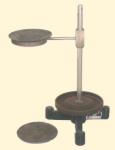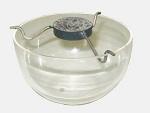

 Menu
Menu
|
Function Showing the possibility of melting the ice at temperatures inferior to zero centigrade. |

| ||
|
|||
|
Description It is composed of a solid cylinder of iron with the bottom adjustable with a screw, of a pressure screw with a waterproof piston and a sphere of steel. By introducing little bits of ice and pressing them with the screw we obtain a homogeneous cylinder of ice. If we put the sphere between the ice and the piston and we keep the temperature low, the intervention of the pressure provokes the fall of the sphere to the bottom of the cylinder. | |||
|
Function Showing the behaviour of water drops on a red-hot surface. |

| ||
|
|||
|
Description The apparatus is formed by a thick 50 mm diameter capsule of copper with a support of iron with variable height. For the experiment the capsule must be polished with emery paper. When the capsule is red hot, we drop water from a pipette, holding the flame under the capsule. When the number of drops is enough to form a 20 mm diameter drop, we take off the flame and can observe the phenomenon of calefaction, which finishes with the evaporation of the drop, as soon as the temperature of the capsule falls under a certain limit. | |||
|
Function Showing the ebullition of a liquid at low temperature in the vacuum. |

| ||
|
|||
|
Description A glass container, ending with two small balloons, contains coloured alcohol. The air has been driven out almost completely with the ebullition of the liquid before the welding, so that the liquid cannot bear any other pressure than that of its own vapour. This pressure is very small at ordinary temperature. If we hold one of the balloons in the hand its heat gives the vapour a pressure that is enough to drive the liquid to the other side and to produce a strong ebullition. | |||
|
Function Studying the evaporation of the water in very rarefied atmosphere. |

| ||
|
|||
|
Description A curved glass tube with two spherical balloons at the end. Some water has been introduced into the tube and has been heated until ebullition, then the glass has been closed. If we make the water pass into the balloons of the short branch, and we immerse the other balloons into the ice, we have a fast and constant distillation from the upper to the lower sphere. The water, that evaporates so quickly, gets so cold that it solidifies. In this experiment it is advisable to put less than half of the liquid in the upper sphere to prevent the glass from breaking at the moment of solidification. It is also advisable to shake the apparatus every now and then to avoid the phenomenon of the supercooling for which the water could freeze abruptly at the first collision and could break the container. | |||
|
Function Studying the vapour tension of various liquids. |

| ||
|
|||
|
Description Four barometer tubes are held vertically over a little celluloid tank. The first tube is a common tube for barometer and it is used for comparison; the other three have a bulging top which communicates with a small funnel. But the communication is closed with a stopcock that is used to transfer a drop of liquid from the funnel to the bulb underneath. After lubricating the first two stopcocks with fat, and the third one with glycerine, we prepare the four tubes as in the experiment of Torricelli. Then we introduce water in the first funnel, in the second we introduce alcohol e in the third ether, and we turn the keys, until we can see, on the meniscus of mercury, the liquid that has passed into the barometric room. At that moment we are in the presence of saturated vapour of water, alcohol, ether, the maximum vapour pressure at room temperature of which is measured by the difference between the columns of the closed tube and the columns of mercury that result after the introduction of the liquids. We find that at the temperature of 20 °C, there is a difference in height of 17 mm for the water, a difference of 14 mm for the alcohol, a difference of 430 mm for the ether. When we warm or we cool the tubes, these values increase or decrease. | |||
|
Function Studying the adiabatic evaporation of a liquid. For the freezing of the water under a bell jar. |

| ||
|
|||
|
Description On the edge of a small glass tank that must hold sulphuric acid or sticks of caustic potash or calcium carbide, we put a brass tripod, that carries a saucer with a smoked cork bottom. On the cork we put a large drop of water that can freeze because of the evaporation under the bell jar. $nbsp; During the experiment it is better to make the drop vibrate in order to free it from the air it can hold. | |||
|
Function Studying the behaviour of a liquid in a particular condition. |

| ||
|
|||
|
Description When the tube is introduced into a large tube full of water at 35 °C, held by a metallic thread opportunely wrapped, the liquid boils and dilates with a coefficient of expansion seven times greater than that of the gases. In the meantime the meniscus becomes mobile and oscillating, and dissolves into a blue opalescence ring and then disappears. At the critical temperature of 30.9 °C the pressure is 72 atm. and the passage from the liquid phase to the gaseous phase happens without absorption of heat. Every minimal change of temperature determines great changes of density, and these produce in the fluid mass appearances similar to those produced by the mixing of non-coloured liquids or by the air that flows on the surface of a hot body. The tube contains liquid carbon dioxide for about two thirds of its own volume at ordinary temperature. | |||
|
Function Measure of the humidity of the air. |

| ||
|
|||
|
Description The support is made a half round wood column with a base and of a little table. Two thermometers and a glass test tube linked to a container are fixed to the table. The bulb of one thermometer protected by a linen is inserted into the test tube. This is kept wet by the liquid that comes for the container. The evaporation of the liquid removes heat from the thermometer. For this it shows a temperature lower than the dry thermometer. From the difference of the temperatures we can infer the relative humidity of the air. | |||